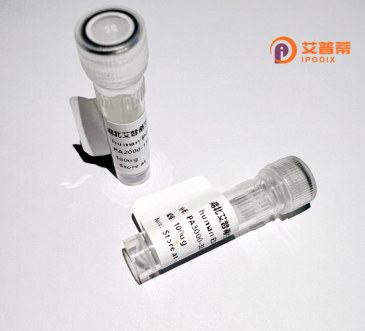
| 纯度 | >90%SDS-PAGE. |
| 种属 | Human |
| 靶点 | ARFGAP2 |
| Uniprot No | Q8N6H7 |
| 内毒素 | < 0.01EU/μg |
| 表达宿主 | E.coli |
| 表达区间 | 2-521aa |
| 氨基酸序列 | AAEPNKTEI QTLFKRLRAV PTNKACFDCG AKNPSWASIT YGVFLCIDCS GVHRSLGVHL SFIRSTELDS NWNWFQLRCM QVGGNANATA FFRQHGCTAN DANTKYNSRA AQMYREKIRQ LGSAALARHG TDLWIDNMSS AVPNHSPEKK DSDFFTEHTQ PPAWDAPATE PSGTQQPAPS TESSGLAQPE HGPNTDLLGT SPKASLELKS SIIGKKKPAA AKKGLGAKKG LGAQKVSSQS FSEIERQAQV AEKLREQQAA DAKKQAEESM VASMRLAYQE LQIDRKKEEK KLQNLEGKKR EQAERLGMGL VSRSSVSHSV LSEMQVIEQE TPVSAKSSRS QLDLFDDVGT FASGPPKYKD NPFSLGESFG SRWDTDAAWG MDRVEEKEPE VTISSIRPIS ERATNRREVE SRSSGLESSE ARQKFAGAKA ISSDMFFGRE VDAEYEARSR LQQLSGSSAI SSSDLFGDMD GAHGAGSVSL GNVLPTADIA QFKQGVKSVA GKMAVLANGV MNSLQDRYGS Y |
| 分子量 | 56.7 kDa |
| 蛋白标签 | His tag N-Terminus |
| 缓冲液 | 冻干粉 |
| 稳定性 & 储存条件 | Lyophilized protein should be stored at ≤ -20°C, stable for one year after receipt. Reconstituted protein solution can be stored at 2-8°C for 2-7 days. Aliquots of reconstituted samples are stable at ≤ -20°C for 3 months. |
| 复溶 | Always centrifuge tubes before opening.Do not mix by vortex or pipetting. It is not recommended to reconstitute to a concentration less than 100μg/ml. Dissolve the lyophilized protein in distilled water. Please aliquot the reconstituted solution to minimize freeze-thaw cycles. |
以下是与ARFGAP2相关的3篇代表性文献及其摘要概述:
1. **文献名称**:*"ARFGAP2 regulates vesicular transport in the Golgi apparatus through its interaction with ADP-ribosylation factor 1"*
**作者**:Yamaguchi T, et al.
**摘要**:该研究证实ARFGAP2通过与ARF1相互作用促进其GTP水解活性,调控高尔基体相关的囊泡运输,并揭示了其在维持膜结构动态平衡中的关键作用。
2. **文献名称**:*"Structural basis of ARFGAP2 function in COPI vesicle formation"*
**作者**:Foldauer M, et al.
**摘要**:通过晶体结构解析,研究揭示了ARFGAP2的GAP结构域与ARF1结合的分子机制,阐明其在COPI囊泡形成中通过诱导ARF1构象变化驱动膜变形的作用。
3. **文献名称**:*"ARFGAP2 promotes hepatocellular carcinoma progression through modulating cell proliferation and invasion"*
**作者**:Zhang L, et al.
**摘要**:该研究首次发现ARFGAP2在肝癌中高表达,并通过调控细胞周期蛋白和MMP信号通路促进肿瘤细胞的增殖与迁移,提示其作为潜在治疗靶点的可能性。
若需扩展,可补充:
4. **文献名称**:*"ARFGAP2 mediates autophagy via interaction with LC3 and affects cellular stress response"*
**作者**:Cheng Y, et al.
**摘要**:研究揭示ARFGAP2通过与自噬标记蛋白LC3结合,调控细胞自噬进程,影响内质网应激条件下的细胞存活,为ARFGAP2在代谢疾病中的作用提供了新视角。
以上文献分别从分子机制、结构生物学、疾病关联及细胞通路层面总结了ARFGAP2的功能。
ARFGAP2 (ADP-ribosylation factor GTPase-activating protein 2) is a member of the ARFGAP family, which regulates the activity of ADP-ribosylation factor (ARF) proteins—small GTPases critical for intracellular membrane trafficking, vesicle formation, and cytoskeletal organization. ARFGAP2 specifically functions as a GTPase-activating protein (GAP) that accelerates the hydrolysis of GTP bound to ARF proteins, switching them from an active (GTP-bound) to an inactive (GDP-bound) state. This activity is essential for the uncoating of COPI-coated vesicles during retrograde transport within the Golgi apparatus and endoplasmic reticulum. Structurally, ARFGAP2 contains a conserved GAP domain responsible for its catalytic function and a unique SAM (sterile alpha motif) domain that may mediate protein-protein interactions or oligomerization. Unlike its close homolog ARFGAP1. ARFGAP2 exhibits distinct regulatory mechanisms, potentially involving interactions with coatomer complexes or lipid membranes. Studies suggest its role in maintaining Golgi structure, cargo sorting, and lipid homeostasis. Dysregulation of ARFGAP2 has been tentatively linked to cancers and neurodegenerative disorders, possibly due to disrupted vesicular trafficking or signaling pathways. Additionally, it is implicated in cellular stress responses and may be transcriptionally regulated by p53. hinting at broader roles in tumor suppression. Research on ARFGAP2 remains ongoing, with emerging interest in its post-translational modifications and tissue-specific functions.
×